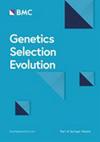Natural clines and human management impact the genetic structure of Algerian honey bee populations
IF 3.6
1区 农林科学
Q1 AGRICULTURE, DAIRY & ANIMAL SCIENCE
引用次数: 0
Abstract
The Algerian honey bee population is composed of two described subspecies A. m. intermissa and A. m. sahariensis, of which little is known regarding population genomics, both in terms of genetic differentiation and of possible contamination by exogenous stock. Moreover, the phenotypic differences between the two subspecies are expected to translate into genetic differences and possible adaptation to heat and drought in A. m. sahariensis. To shed light on the structure of this population and to integrate these two subspecies in the growing dataset of available haploid drone sequences, we performed whole-genome sequencing of 151 haploid drones. Integrated analysis of our drone sequences with a similar dataset of European reference populations did not detect any significant admixture in the Algerian honey bees. Interestingly, most of the genetic variation was not found between the A. m. intermissa and A. m. sahariensis subspecies; instead, two main genetic clusters were found along an East–West axis. We found that the correlation between genetic and geographic distances was higher in the Western cluster and that close-family relationships were mostly detected in the Eastern cluster, sometimes at long distances. In addition, we selected a panel of 96 ancestry-informative markers to decide whether a sampled bee is Algerian or not, and tested this panel in simulated cases of admixture. The differences between the two main genetic clusters suggest differential breeding management between eastern and western Algeria, with greater exchange of genetic material over long distances in the east. The lack of detected admixture events suggests that, unlike what is seen in many places worldwide, imports of queens from foreign countries do not seem to have occurred on a large scale in Algeria, a finding that is relevant for conservation purposes. In addition, the proposed panel of 96 markers was found effective to distinguish Algerian from European honey bees. Therefore, we conclude that applying this approach to other taxa is promising, in particular when genetic differentiation is difficult to capture.自然克隆和人为管理对阿尔及利亚蜜蜂种群遗传结构的影响
阿尔及利亚蜜蜂种群由两个已描述的亚种 A. m. intermissa 和 A. m. sahariensis 组成,对其种群基因组学知之甚少,包括遗传分化和可能的外源种群污染。此外,这两个亚种之间的表型差异有望转化为 A. m. sahariensis 的遗传差异以及对高温和干旱的可能适应。为了揭示该种群的结构,并将这两个亚种纳入不断增长的现有单倍体无人机序列数据集中,我们对 151 只单倍体无人机进行了全基因组测序。我们将无人机序列与欧洲参考种群的类似数据集进行了整合分析,结果发现阿尔及利亚蜜蜂没有明显的外来混杂。有趣的是,大部分遗传变异并不存在于 A. m. intermissa 和 A. m. sahariensis 亚种之间;相反,沿着东西轴线发现了两个主要的遗传集群。我们发现,遗传距离和地理距离之间的相关性在西部聚类中更高,而近亲关系大多在东部聚类中发现,有时距离还很远。此外,我们还选择了一个由 96 个祖先信息标记组成的小组,以确定取样蜜蜂是否为阿尔及利亚人,并在模拟的混血案例中对该小组进行了测试。两个主要基因群之间的差异表明,阿尔及利亚东部和西部的育种管理存在差异,东部的遗传物质长距离交换更多。没有发现掺杂事件表明,与世界上许多地方的情况不同,阿尔及利亚似乎没有大规模地从外国引进蜂王,这一发现与保护目的有关。此外,我们还发现拟议的 96 个标记组能有效区分阿尔及利亚蜜蜂和欧洲蜜蜂。因此,我们认为将这种方法应用于其他类群是很有前景的,尤其是在遗传分化难以捕捉的情况下。
本文章由计算机程序翻译,如有差异,请以英文原文为准。
求助全文
约1分钟内获得全文
求助全文
来源期刊

Genetics Selection Evolution
生物-奶制品与动物科学
CiteScore
6.50
自引率
9.80%
发文量
74
审稿时长
1 months
期刊介绍:
Genetics Selection Evolution invites basic, applied and methodological content that will aid the current understanding and the utilization of genetic variability in domestic animal species. Although the focus is on domestic animal species, research on other species is invited if it contributes to the understanding of the use of genetic variability in domestic animals. Genetics Selection Evolution publishes results from all levels of study, from the gene to the quantitative trait, from the individual to the population, the breed or the species. Contributions concerning both the biological approach, from molecular genetics to quantitative genetics, as well as the mathematical approach, from population genetics to statistics, are welcome. Specific areas of interest include but are not limited to: gene and QTL identification, mapping and characterization, analysis of new phenotypes, high-throughput SNP data analysis, functional genomics, cytogenetics, genetic diversity of populations and breeds, genetic evaluation, applied and experimental selection, genomic selection, selection efficiency, and statistical methodology for the genetic analysis of phenotypes with quantitative and mixed inheritance.
 求助内容:
求助内容: 应助结果提醒方式:
应助结果提醒方式:


